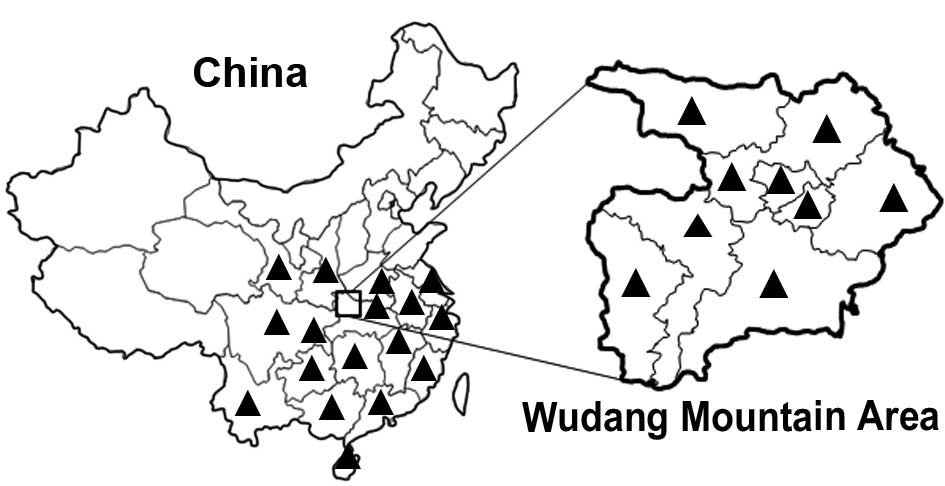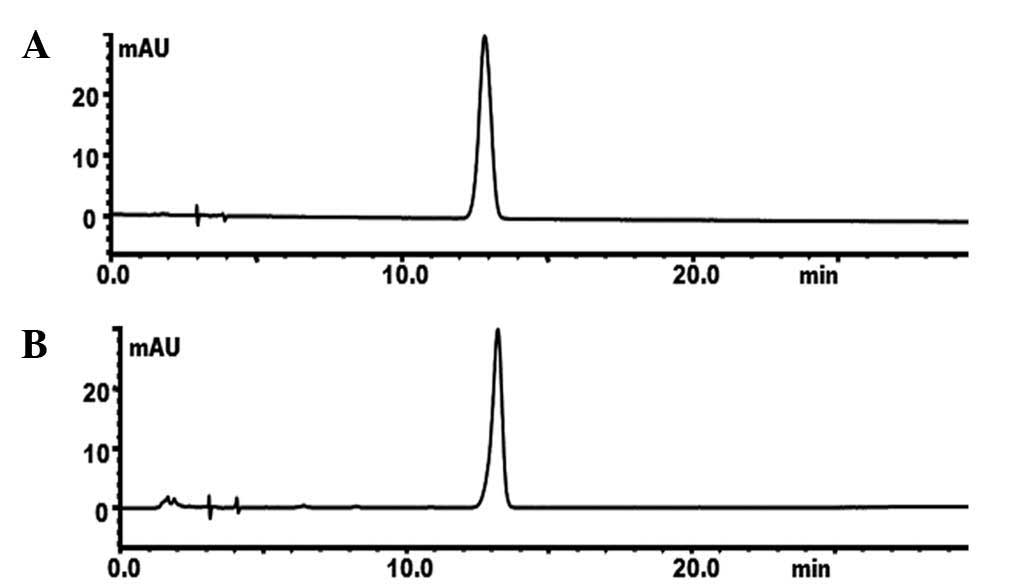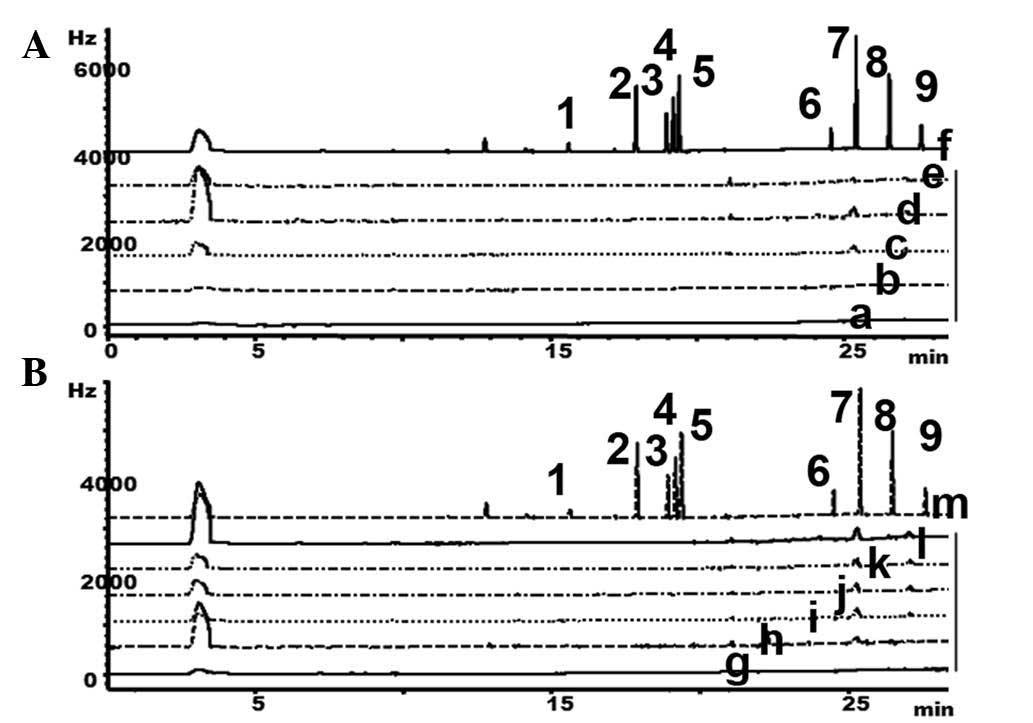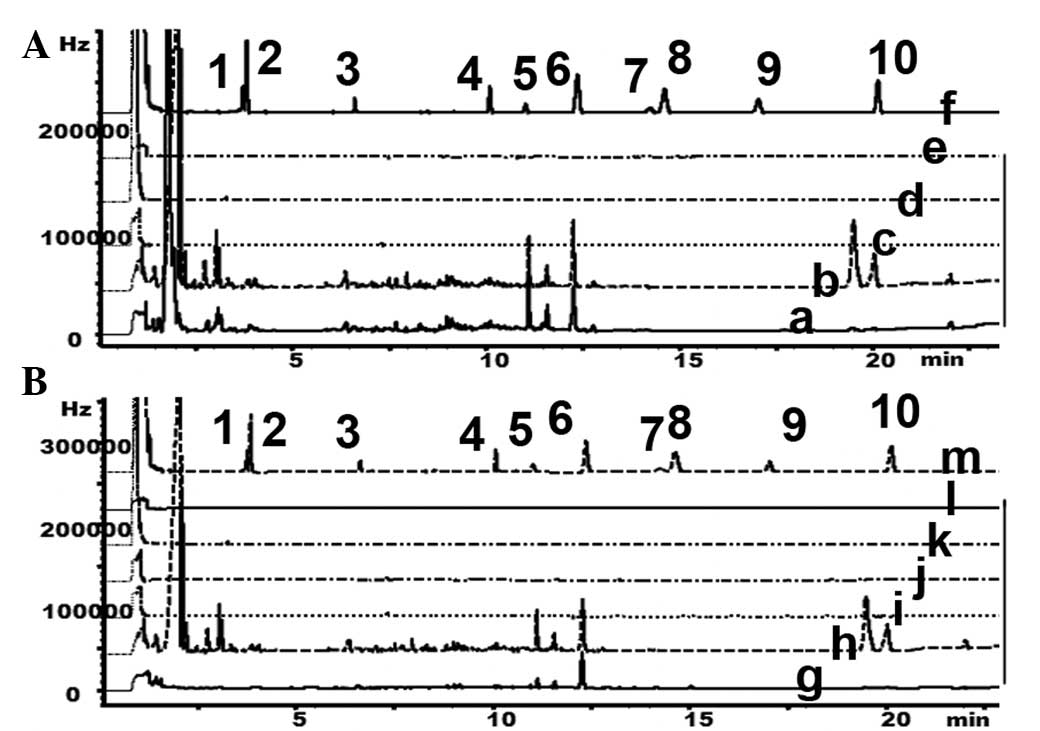|
1
|
Wen MX: The formation and development of
complementary medicine in Wudang Taoism. Hu Nan Zhong Yi Xue Yuan
Xue Bao. 26:14–15. 2006.(In Chinese).
|
|
2
|
Xu D, Wang D, Hu J, Xiong T and Zhu Y:
Study on development history of Taoist medicine in Wudang. Zhonghua
Yi Shi Za Zhi. 30:225–227. 2000.(In Chinese). PubMed/NCBI
|
|
3
|
Chai Y, Xu Z, Wang B and Mao Z: Studies on
rural residents' utilization and tendency of traditional Chinese
drugs in Wudang Town. Shaanxi Zhong Yi Xue Yuan Xue Bao. 28:67–68.
2005.(In Chinese).
|
|
4
|
Commission of Chinese Pharmacopoeia:
Heshouwu, . Pharmacopoeia of the People's Republic of China. 1.
1st. China Medico-Pharmaceutical Science & Technology
Publishing House; Beijing: pp. 164–165. 2010, (In Chinese).
|
|
5
|
Chen JY, Tu HJ, Tu ZL and Li GF:
HeshouwuMateria Medica in Wudang, China. Hubei Ke Xue Chu Ban She;
Wuhan, China: pp. 200–207. 2009, (In Chinese).
|
|
6
|
Shang R: Kan Gua formula in Taoist
medicine. Wu Dang. 55–56. 2004.(In Chinese).
|
|
7
|
Shang R: Introduction of plasters of
Wudang Taoist medicine for gynaecology. Wu Dang. 52–53. 2006.(In
Chinese).
|
|
8
|
Hou JY and Fang TH: Pharmacology of
Chinese Materia Medica. 2nd. Zhong Guo Zhong Yi Yao Chu Ban She;
Beijing, China: pp. 230–232. 2007, (In Chinese).
|
|
9
|
Commission of Chinese Pharmacopoeia.
Appendum, Methods of residues of pesticidesPharmacopoeia of the
People's Republic of China. 1. 1st. China Medico-Pharmaceutical
Science & Technology Publishing House; Beijing: appendum. 2010,
(In Chinese).
|
|
10
|
Da C, Liu G, Tang Q and Liu J:
Distribution, sources, and ecological risks of organochlorine
pesticides in surface sediments from the Yellow River Estuary,
China. Environ Sci Process Impacts. 15:2288–2296. 2013. View Article : Google Scholar : PubMed/NCBI
|
|
11
|
Yang Y, Asiri AM, Du D and Lin Y:
Acetylcholinesterase biosensor based on a gold
nanoparticle-polypyrrole-reduced graphene oxide nanocomposite
modified electrode for the amperometric detection of
organophosphorus pesticides. Analyst (Lond). 139:3055–3060. 2014.
View Article : Google Scholar
|
|
12
|
Hu X, Shi W, Yu N, Jiang X, Wang S, Giesy
JP, Zhang X, Wei S and Yu H: Bioassay-directed identification of
organic toxicants in water and sediment of Tai Lake, China. Water
Res. 73:231–241. 2015. View Article : Google Scholar : PubMed/NCBI
|
|
13
|
Tang X, Liang B, Yi T, Manco G, Palchetti
I and Liu A: Cell surface display of organophosphorus hydrolase for
sensitive spectrophotometric detection of p-nitrophenol substituted
organophosphates. Enzyme Microb Technol. 55:107–112. 2014.
View Article : Google Scholar : PubMed/NCBI
|
|
14
|
Wu L, Yao J, Trebse P, Zhang N and Richnow
HH: Compound specific isotope analysis of organophosphorus
pesticides. Chemosphere. 111:458–463. 2014. View Article : Google Scholar : PubMed/NCBI
|
|
15
|
Yu G, Wu W, Zhao Q, Wei X and Lu Q:
Efficient immobilization of acetylcholinesterase onto amino
functionalized carbon nanotubes for the fabrication of high
sensitive organophosphorus pesticides biosensors. Biosens
Bioelectron. 68:288–294. 2015. View Article : Google Scholar : PubMed/NCBI
|
|
16
|
Liu X, Li D, Li J, Rose G and Marriott PJ:
Organophosphorus pesticide and ester analysis by using
comprehensive two-dimensional gas chromatography with flame
photometric detection. J Hazard Mater. 263:761–767. 2013.
View Article : Google Scholar : PubMed/NCBI
|
|
17
|
Yuan Z, Yao J, Liu H, Han J and Trebše P:
Photodegradation of organophosphorus pesticides in honey medium.
Ecotoxicol Environ Saf. 108:84–88. 2014. View Article : Google Scholar : PubMed/NCBI
|
|
18
|
Wen MX: History and Characters of Wudang
Taoist Medicine. Nei Meng Gu Zhong Yi Yao. 32:118–119. 2013.(In
Chinese).
|
|
19
|
Shang R: Properties of Taoist medicine in
Wudang. Wudang. 37–39. 2011.(In Chinese).
|
|
20
|
Xu D: Nature of Wudang Taoist Medicine. Wu
Dang. 49–50. 2006.
|
|
21
|
Lin L, Ni B, Lin H, Zhang M, Li X, Yin X,
Qu C and Ni J: Traditional usages, botany, phytochemistry,
pharmacology and toxicology of Polygonum multiflorum Thunb.: A
review. J Ethnopharmacol. 159:158–183. 2015. View Article : Google Scholar : PubMed/NCBI
|
|
22
|
Zhou XX, Yang Q, Xie YH, Sun JY, Qiu PC,
Cao W and Wang SW: Protective effect of tetrahydroxystilbene
glucoside against D-galactose induced aging process in mice.
Phytochem Lett. 6:372–378. 2013. View Article : Google Scholar
|
|
23
|
Chen Q, Zhang SZ, Ying HZ, Dai XY, Li XX
and Yu CH and Yu CH: Chemical characterization and
immunostimulatory effects of a polysaccharide from Polygoni
Multiflori Radix Praeparata in cyclophosphamide-induced anemic
mice. Carbohyd Polym. 88:1476–1482. 2012. View Article : Google Scholar
|
|
24
|
Wang W, He Y, Lin P, Li Y, Sun R, Gu W, Yu
J and Zhao R: In vitro effects of active components of Polygonum
Multiflorum Radix on enzymes involved in the lipid metabolism. J
Ethnopharmacol. 153:763–770. 2014. View Article : Google Scholar : PubMed/NCBI
|
|
25
|
Wang M, Zhao R, Wang W, Mao X and Yu J:
Lipid regulation effects of Polygoni Multiflori Radix, its
processed products and its major substances on steatosis human
liver cell line L02. J Ethnopharmacol. 139:287–293. 2012.
View Article : Google Scholar : PubMed/NCBI
|
|
26
|
Lin P, He YR, Lu JM, Li N, Wang WG, Gu W,
Yu J and Zhao RH: In vivo lipid regulation mechanism of polygoni
multiflori radix in high-fat diet fed rats. Evid Based Complement
Alternat Med. 2014:6420582014. View Article : Google Scholar : PubMed/NCBI
|
|
27
|
Lee BH, Huang YY, Duh PD and Wu SC:
Hepatoprotection of emodin and Polygonum multiflorum against
CCl(4)-induced liver injury. Pharm Biol. 50:351–359. 2012.
View Article : Google Scholar : PubMed/NCBI
|
|
28
|
Jin W: Studies of Zhiheshouwu on
CCl4-induced liver fibrosis in rats. Masters ThesisDalian Medical
University Dalian: 2004, (In Chinese).
|
















